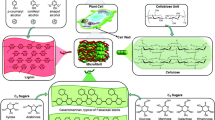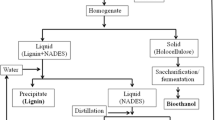Abstract
To enhance the conversion of the cellulose and hemicellulose, the corncob pretreated by aqueous ammonia soaking was hydrolyzed by enzyme complexes. The saturation limit for cellulase (Spezyme CP) was determined as 15 mg protein/g glucan (50 filter paper unit (FPU)/g glucan). The accessory enzymes (β-glucosidase, xylanase, and pectinase) were supplemented to hydrolyze cellobiose (cellulase-inhibiting product), hemicellulose, and pectin (the component covering the fiber surfaces), respectively. It was found that β-glucosidase (Novozyme 188) loading of 1.45 mg protein/g glucan [30 cellobiase units (CBU)/g glucan] was enough to eliminate the cellobiose inhibitor, and 2.9 mg protein/g glucan (60 CBU/g glucan) was the saturation limit. The supplementation of xylanase and pectinase can increase the conversion of cellulose and hemicellulose significantly. The yields of glucose and xylose enhanced with the increasing enzyme loading, but the increasing trend became low at high loading. Compared with xylanase, pectinase was more effective to promote the hydrolysis of cellulose and hemicellulose. The supplementation of pectinase with 0.12 mg protein/g glucan could increase the yields of glucose and xylose by 7.5% and 29.3%, respectively.






Similar content being viewed by others

References
McKendry, P. (2002). Bioresource Technology, 83, 37–46. doi:10.1016/S0960-8524(01) 00118-3.
Gusakov, A. V., Salanovich, T. N., Antonov, A. I., Ustinov, B. B., Okunev, O. N., Burlingame, R., et al. (2007). Biotechnology and Bioengineering, 97, 1028–1038. doi:10.1002/bit.21329.
Tengborg, C., Galbe, M., & Zacchi, G. (2001). Biotechnology Progress, 17, 110–117. doi:10.1021/bp000145+.
Ortega, N., Busto, M. D., & Perez-Mateos, M. (2000). Biocatalysis and Biotransformation, 18, 311–330. doi:10.3109/10242420009015254.
Ohgren, K., Bura, R., Saddler, J., & Zacchi, G. (2007). Bioresource Technology, 98, 2503–2510. doi:10.1016/j.biortech.2006.09.003.
Berlin, A., Maximenko, V., Gilkes, N., & Saddler, J. (2007). Biotechnology and Bioengineering, 97, 287–296. doi:10.1002/bit.21238.
Kim, T. H., Kim, J. S., Sunwoo, C., & Lee, Y. Y. (2003). Bioresource Technology, 90, 39–47. doi:10.1016/S0960-8524(03) 00097-X.
Wyman, C. E., Dale, B. E., Elander, R. T., Holtzapple, M., Ladisch, M. R., & Lee, Y. Y. (2005). Bioresource Technology, 96, 1959–1966. doi:10.1016/j.biortech.2005.01.010.
Kim, T. H., & Lee, Y. Y. (2005). Applied Biochemistry and Biotechnology, 121, 1119–1131. doi:10.1385/ABAB:124:1-3:1119.
Isci, A., Himmelsbach, J. N., Pometto, A. L., Raman, D. R., & Anex, R. P. (2008). Applied Biochemistry and Biotechnology, 144, 69–77. doi:10.1007/s12010-007-8008-z.
Bradford, M. M. (1976). Analytical Biochemistry, 72, 248–254. doi:10.1016/0003-2697(76) 90527-3.
Wood, T. M., & Bhat, K. M. (1988). Methods in Enzymology, 160, 87–112. doi:10.1016/0076-6879(88) 60109-1.
Galbe, M., & Zacchi, G. (2002). Applied Microbiology and Biotechnology, 59, 618–628. doi:10.1007/s00253-002-1058-9.
Nieves, R. A., Ehrman, C. I., Adney, W. S., Elander, R. T., & Himmel, M. E. (1998). World Journal of Microbiology & Biotechnology, 14, 301–304. doi:10.1023/A:1008871205580.
Bezerra, R. M. F., & Dias, A. A. (2005). Applied Biochemistry and Biotechnology, 126, 49–59. doi:10.1007/s12010-005-0005-5.
Gupta, R., Kim, T. H., & Lee, Y. Y. (2008). Applied Biochemistry and Biotechnology, 148, 59–70. doi:10.1007/s12010-007-8071-5.
Carpita, N. C., & Gibeaut, D. M. (1993). The Plant Journal, 3, 1–30. doi:10.1111/j.1365-313X.1993.tb00007.x.
Acknowledgments
The authors acknowledge the financial supports received from Natural Science Foundation of China (no. 20576095), National Key Technology R&D program (2007BAD42B02), the International Science and Technology cooperation program (2006DA62400), the Programme of Introducing Talents of Discipline to Universities of China (No. B06006), and the Program for Changjiang Scholars and Innovative Research Team in University of China (IRT0641).
Author information
Authors and Affiliations
Corresponding author
Rights and permissions
About this article
Cite this article
Zhang, M., Su, R., Qi, W. et al. Enhanced Enzymatic Hydrolysis of Lignocellulose by Optimizing Enzyme Complexes. Appl Biochem Biotechnol 160, 1407–1414 (2010). https://doi.org/10.1007/s12010-009-8602-3
Received:
Accepted:
Published:
Issue Date:
DOI: https://doi.org/10.1007/s12010-009-8602-3



